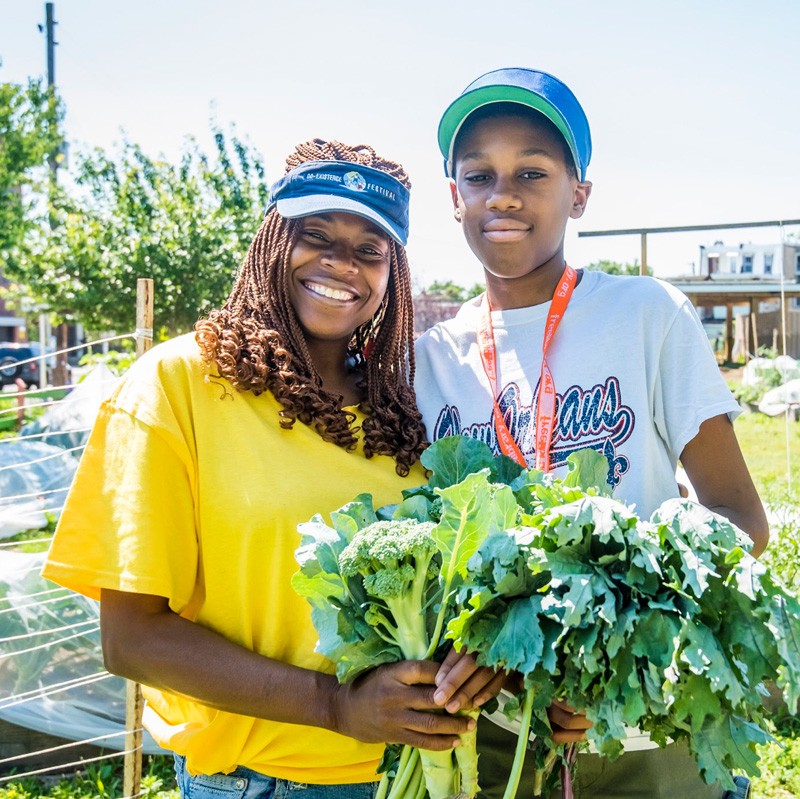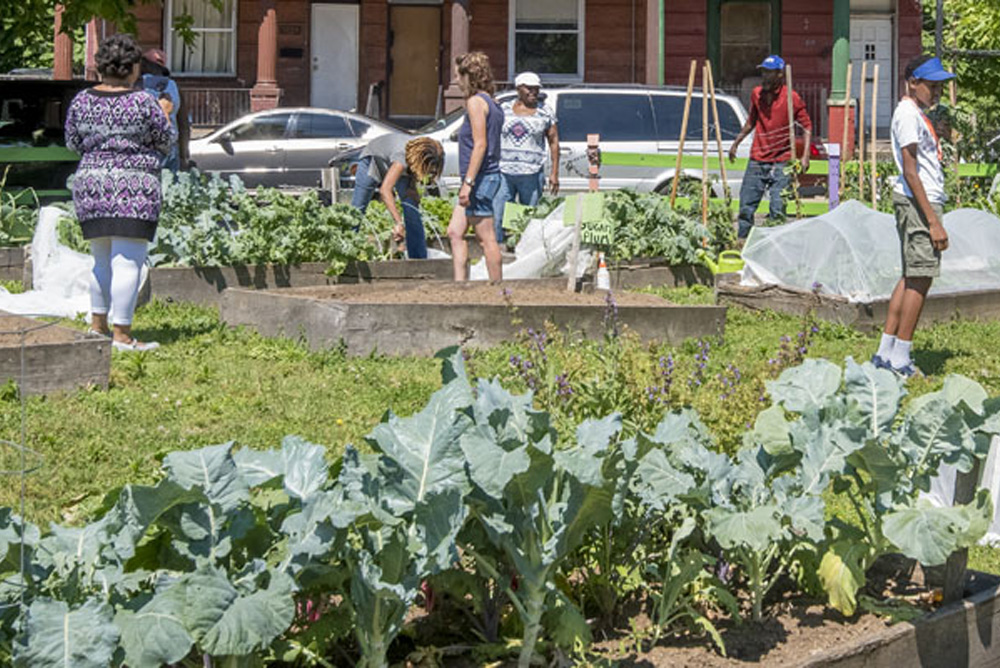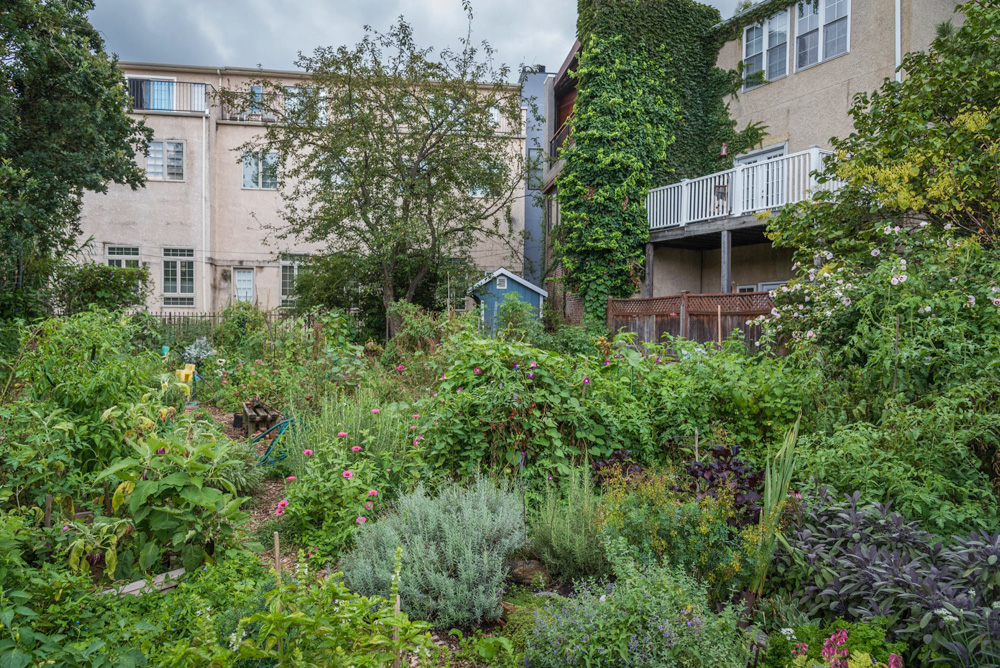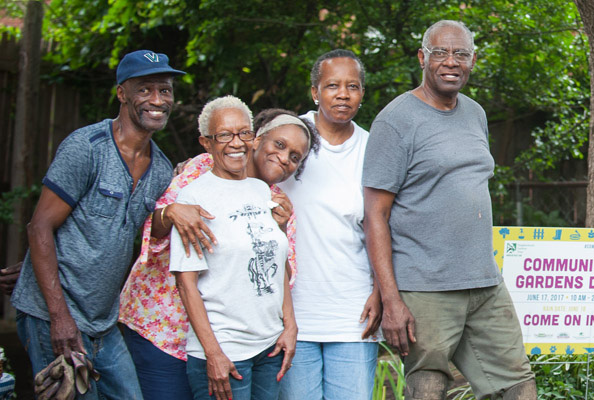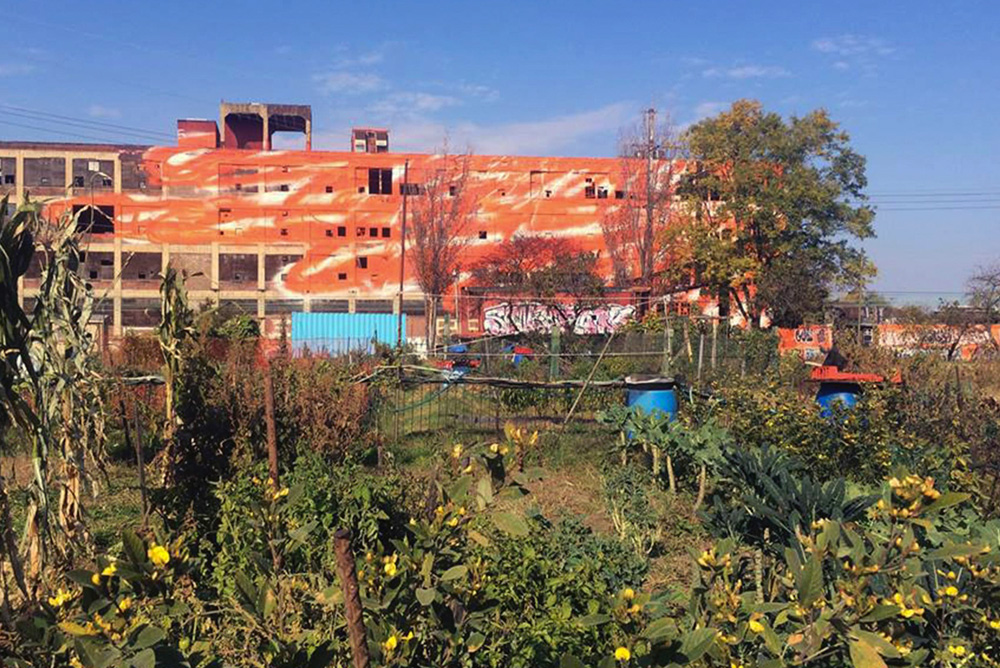Community Gardens
Location: Philadelphia
Organization: Neighborhood Gardens Trust (formerly the Neighborhood Gardens Association)
James Taylor wakes at 4 a.m., crosses his street of tidy row homes, and opens the gate to Glenwood Green Acres. Four acres of green purpose meet his pale gray eyes.
If Taylor turned his gaze north, the outline of Center City Philadelphia would pierce the dimly lit sky, an abandoned factory loitering in the foreground. Instead he looks straight ahead to his neighborhood’s garden. Taylor and his late wife founded Glenwood Green Acres community garden nearly 20 years ago, following a fire that destroyed the factory that once stood here at the 1800 block of Glenwood Avenue.
“My wife loved this garden so much I thought I’d put that right here,” Taylor said, gesturing towards a cornerstone, honoring the founding couple. “She was always out here.”
Urban gardening isn’t a new concept. What is special about Glenwood and other Philadelphia gardens is that they are protected. The gardens can’t be shut down, paved, or built on.
“Most community gardeners do not own the land where they garden,” said Terry Mushovic, executive director of Neighborhood Gardens Association/A Philadelphia Land Trust. “They are always at risk of being asked to leave. We try to save the better ones that are out there and help the city in creatively dealing with all the vacant space.”
Glenwood Green Acres is one of 22 gardens owned by the Neighborhood Gardens Association/A Philadelphia Land Trust. The organization holds long-term leases on two other gardens and is working to protect dozens more. Its mission is to ensure the continuity and preservation of community managed gardens and open space in low to moderate-income neighborhoods. Taylor and 80 of his neighbors, their children and grandchildren will always have the opportunity to garden the land.
Philadelphia has 31,000 vacant lots, most of them derelict. Over the past two decades, local people have constructively redeveloped 1,200 of these areas into community gardens — converting neighborhood liabilities into neighborhood assets.
Folks get attached to the gardens. In the city, two blocks away can be an entirely different neighborhood with its own culture, and the garden is part of the culture. Unfortunately, upon occasion a long absent property owner shows up, and the people who poured their sweat and money into the land are out-of-luck.
The Neighborhood Gardens Association works to avoid this unpleasant scenario. By acquiring properties or helping other community groups to do so, NGA ensures that James Taylor will never have to move his cotton and tobacco plants.
Urban Growth
On hot summer days, Susan White takes breaks from her vegetables and flowers to relax in Seedy Acres’ shade with infant daughter, Katsura.
The community garden, in the Northern Liberties part of Philadelphia, has growing plots and a common area where picnics and fundraisers are held. “The gardens bring people together,” White said. “I live in my little house and you live in your little house. In the garden I talk to people I never would have if it wasn’t here.”
“I never would have talked to her — ever,” quipped Sally McCabe, a fellow gardener.
NGA owns about one-third of the lots that comprise Seedy Acres. The owners of some are unknown and still others are becoming known as sales of small lots increase in the recently popular residential area.
I’ve raised my babies here,” McCabe said of her fourteen and ten-year old children. “Katsura is the neighborhood’s ninth baby to be raised in the garden.”
NGA hopes to purchase two additional lots so that baby number 10, 11 and 12 can be raised with green space outside their doors.
Flower Power
Stillman Street in Philadelphia is lined with the old brick town homes that typify the region. Flowers spill from windowsills and hanging baskets grace porches of the well-kept homes.
It’s hard to believe that a building once stood in the tiny lot where Jane Gourley and neighbors grow ornamentals and flowers. When the building was demolished, the corner property remained vacant, except for the accumulating garbage.
But Gourley is as feisty as her flowers are colorful. She put up signs demanding that trash not be left on the lot. By 1993 she was organizing neighbors to clean the lot. Then the gardening began. Residents were so enthusiastic that donations of potted plants would mysteriously appear on the lot from time to time.
Gourley contacted NGA for help in making the garden a permanent fixture. NGA purchased the lot from a private owner in 1994.
“A lot of people appreciate the garden,” said Bill O’Donnell, a fellow gardener. “Even if they don’t plant here, when they walk by they say thank you.”
Support for the garden comes in the currency of kind words and loose change. Rose’s Deli on the corner of Stillman and Parish keeps a collection can for garden supplies on its counter. The nickels and dimes totaled $200 this growing season.
Feed the Block
For 17 years Leon Green has been working in Glenwood Green Acres. Now retired, he labors in the soil full-time and has increased the number of plots he works. Green produces bushels of green beans, sweet potatoes, watermelon, butter beans, okra and potatoes in a season.
On a hot July afternoon, Green fussed over the little green infant of a watermelon, the first of the season to appear on the vine.
“When the kids were smaller I used to feed the family from the garden,” Green said. “Now I give it to people on the block who are less fortunate than me.”
How Does Your Garden Grow?
The genesis of city gardens is usually a community response to the negative impact of vacant lots near their homes. When structures come down, owners often become tax delinquent or do nothing with their lots, unless property values improve. Trash accumulates. The neighbors eventually get sick of the ugliness and clean it up. One things lead to another, and soon they find themselves building gardens. The Neighborhood Gardens Association then helps the neighbors make their improvements permanent.
NGA’s 24 gardens are as diverse as the neighborhoods where they grow: Some are small, some large; some are packed with flowers and others sustain families with produce. But all the gardens have people in common — people who invest physical and emotional labor, year after year.
“We’re white, African-American and Hispanic in background,” said Barbara Wolf, of the North Street Garden “After we’ve had an afternoon of hard work and dirty hands, we get to eat, laugh and catch up on neighborhood and family issues. It’s a wonderful way to create neighborhood camaraderie and good will.”
“Our garden is important to us because it is a green and living oasis of beauty and sustenance in the middle of a congested neighborhood,” explained Fred Snyder, a gardener at NGA’s Queen Village Garden. “It is our escape, a couple of blocks from where we live, and allows us to feel as though we are in the country.”
